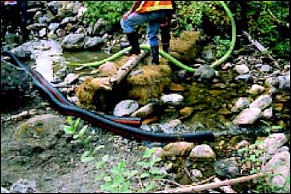| Forest Road Deactivation Practices | |
| in the Pacific Northwest | |
| 23 - Stream Diversion Dams | Downstream Dam, Upstream Dam |
Diversion of a stream can be achieved with a diversion ditch, a gravity system, or a "pump-around". The diversion ditch is specifically built around the culvert to allow its removal, therefore the diversion dam is simply diverting the flow. Keep in mind that you have to reestablish the creek channel after you have removed the drainage structure. For pump-arounds and gravity systems, dams have to retain all the water in the original stream channel to dry up the work site.
Build the downstream dam from hay bales wrapped in filter cloth, just below your work site at a wide spot in the creek (low velocity). Stay as close as possible to the drainage structure to be deactivated, but leave yourself enough room to work safety. The lower the stream gradient, the further downstream you have to go, otherwise backed up water will saturate your work site. Weigh the hay bales down with rocks, and support the downstream side with rocks also.
The dam's primary purpose is to intercept minor sediment or suspended particles generated during the construction of the upper dam, or during culvert removal if the channel is not completely dry. The dam is also very useful when water is permitted to re-enter the stream channel after the culvert removal. Start up pump(s) as soon as silty water builds up, and pump to a depression in the vicinity that will not allow any erosion. Maintain the downstream dam as long as possible or until water runs clear. In the picture below, note that silty water generated during the crossing deactivation is pumped from the left side of the hay bale dam onto the forest floor nearby. The sections of "Big O" supply clean water from above the work site to fish below the dam.

Build dams with sandbags, from logs or lumber reinforced by a tarp, or with a combination of the above. A water-tight dam is critical as it must capture all the water. It can be difficult to obtain a tight seal along the streambank or in cobbly stream channels. Because your downstream failsafe dam allows you to remove minor sediment, you can create a good sized catch basin for the upstream dam with one scoop of the excavator bucket. From your water manager's tool kit, fill triple garbage bags (60cm x 90cm, or 2ft x 3ft) to 1/4 with sand or gravel, then fold the front of each bag upstream to seal the dam. Use sandbags to secure the intake of the diversion pipe (500 mm or 20" or smaller "Big O") for gravity diversions. Allow enough length for the "Big O" to maintain adequate working space. Calculate the water flow so that you have enough hose and pumps (spares!) and gas for "pump-arounds", but avoid using pumps for jobs which can't be completed in one shift.
Remember that fish have to be removed if you dewater a work site in a fish stream. As electro-shocking is not a reliable method of fish removal in water temperatures below 5°C (41°F), drainage structures may have to be left in place for removal during warmer temperatures.
| 23 - Stream Diversion Dams |
| Next |
||
|
|
|
©1999 - 2002 Flip Productions Limited Used with permission by CulvertBC |